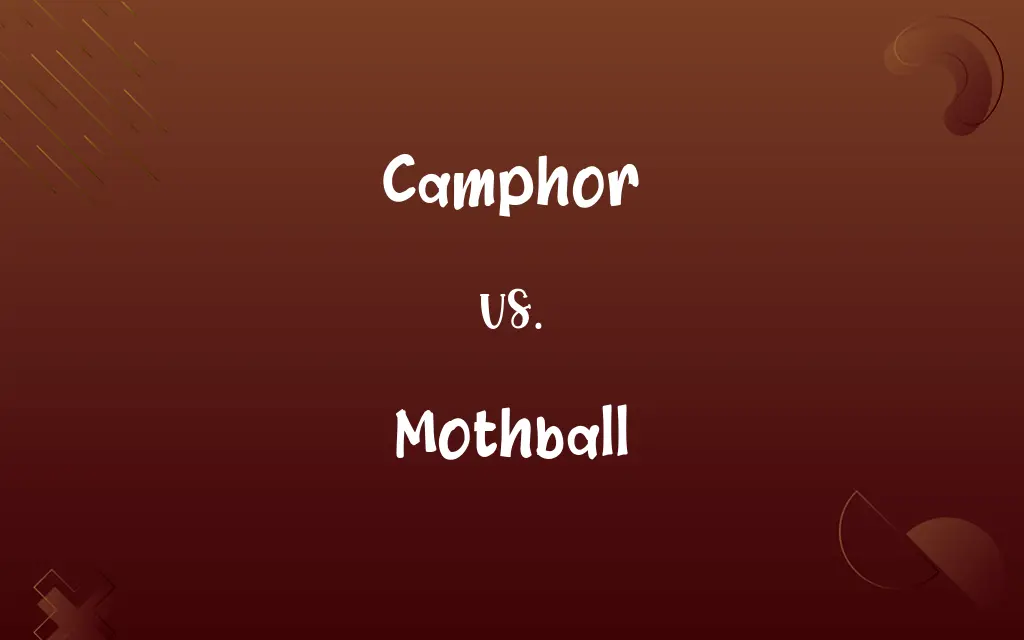Camphor vs. Mothball: Know the Difference

By Shumaila Saeed || Updated on December 25, 2023
Camphor is a white, crystalline substance with a strong odor, used in medicine and as an insect repellent, whereas mothballs are small balls of chemical pesticide and deodorant, primarily used to protect clothes from moths.

Key Differences
Paragraph 1: Origin and Composition
Shumaila Saeed
Dec 04, 2023
Camphor is a naturally occurring compound found in the wood of the camphor laurel tree. It has a strong, penetrating fragrance and is known for its medicinal properties. Mothballs, on the other hand, are manufactured products typically made from naphthalene or paradichlorobenzene, both of which are chemical compounds with a distinct, pungent odor. These substances are primarily used for their ability to repel or kill moths and other insects.
Shumaila Saeed
Dec 04, 2023
While camphor is widely used in medical applications such as pain relief and reducing itching, it is also employed in religious ceremonies and as a moth repellent. Mothballs are specifically designed for protecting clothing and other materials from moth larvae, which can cause significant damage. Unlike camphor, mothballs are not used for medicinal purposes due to their toxic nature.
Shumaila Saeed
Dec 04, 2023
Camphor is a waxy, transparent solid that easily sublimates at room temperature, releasing its characteristic odor. This odor is pleasant to many and is often associated with cleanliness. Mothballs, conversely, are small, white balls that also sublimate at room temperature but tend to have a more pungent and less pleasant odor. The odor of mothballs is often associated with storage or old clothing.
Shumaila Saeed
Dec 04, 2023
Camphor, though natural, can be toxic if ingested in large amounts and must be used with caution. It is generally safe when used in topical applications or in small quantities. Mothballs, made of chemicals like naphthalene, are toxic and can be harmful if inhaled over a long period. They pose a risk to children and pets if accidentally ingested.
Shumaila Saeed
Dec 04, 2023
ADVERTISEMENT
The use of camphor is largely unrestricted and it is widely available in various forms. However, environmental concerns are minimal compared to mothballs. The use and disposal of mothballs, given their chemical composition, are subject to more stringent regulations due to their potential environmental impact and health hazards, particularly their toxicity to wildlife and water sources.
Shumaila Saeed
Dec 04, 2023
Comparison Chart
Primary Use
Medicinal applications, religious ceremonies, insect repellent
Clothing protection, insect repellent
Shumaila Saeed
Dec 04, 2023
Origin
Natural (from camphor laurel tree)
Synthetic (naphthalene or paradichlorobenzene)
Shumaila Saeed
Dec 04, 2023
Odor
Strong, medicinal, sometimes pleasant
Pungent, often associated with storage
Shumaila Saeed
Dec 04, 2023
Safety for Humans
Moderately safe (toxic if ingested in large amounts)
Toxic (harmful if inhaled or ingested)
Shumaila Saeed
Dec 04, 2023
ADVERTISEMENT
Camphor and Mothball Definitions
Camphor
Fragrance Component
The camphor added a refreshing scent to the homemade potpourri.
Shumaila Saeed
Nov 24, 2023
Mothball
Pest Control Agent
Mothballs are placed in wardrobes to prevent moth damage to clothes.
Shumaila Saeed
Nov 24, 2023
Camphor
Insect Repellent
They burned camphor in the room to keep mosquitoes away.
Shumaila Saeed
Nov 24, 2023
ADVERTISEMENT
Camphor
Medicinal Substance
Camphor is used in topical pain relievers for its cooling effect.
Shumaila Saeed
Nov 24, 2023
Mothball
Storage Aid
Mothballs are commonly found in boxes of stored garments.
Shumaila Saeed
Nov 24, 2023
Camphor
Religious Symbol
Camphor is burned in temples as a part of ritual offerings.
Shumaila Saeed
Nov 24, 2023
Mothball
Protective Substance
To preserve her wedding dress, she packed it with mothballs.
Shumaila Saeed
Nov 24, 2023
Camphor
Moth Repellent
Camphor balls are placed in closets as a natural alternative to mothballs.
Shumaila Saeed
Nov 24, 2023
Mothball
Chemical Pesticide
Mothballs contain naphthalene, a strong pesticide.
Shumaila Saeed
Nov 24, 2023
Camphor
A fragrant white or colorless crystalline ketone, C10H16O, obtained naturally from the wood of the camphor tree or synthesized from pinene and used as an insect repellent, in the manufacture of film, plastics, lacquers, and in medicine chiefly in external preparations to relieve mild pain and itching.
Shumaila Saeed
Oct 19, 2023
Mothball
A marble-sized ball, originally of camphor but now of naphthalene, stored with clothes to repel moths.
Shumaila Saeed
Oct 19, 2023
Camphor
(organic compound) A white transparent waxy crystalline isoprenoid ketone, 1,7,7-trimethylbicyclo[2.2.1]heptan-2-one, with a strong pungent odour, used in pharmacy.
Shumaila Saeed
Oct 19, 2023
Mothball
A condition of long storage for possible future use
Put the battleship into mothballs.
Shumaila Saeed
Oct 19, 2023
Camphor
A tough, white, aromatic resin, or gum, obtained from different species of the Laurus family, esp. from Cinnamomum camphara (the Laurus camphora of Linnæus.). Camphor, C10H16O, is volatile and fragrant, and is used in medicine as a diaphoretic, a stimulant, or sedative.
Shumaila Saeed
Oct 19, 2023
Mothball
A condition of being set aside or discarded
Have put the plan into mothballs.
Shumaila Saeed
Oct 19, 2023
Camphor
Originally, a gum resembling ordinary camphor, obtained from a tree (Dryobalanops aromatica formerly Dryobalanops camphora) growing in Sumatra and Borneo; now applied to its main constituent, a terpene alcohol obtainable as a white solid C10H18O, called also Borneo camphor, Malay camphor, Malayan camphor, camphor of Borneo, Sumatra camphor, bornyl alcohol, camphol, and borneol. The isomer from Dryobalanops is dextrorotatory; the levoratatory form is obtainable from other species of plants, and the racemic mixture may be obtained by reduction of camphor. It is used in perfumery, and for manufacture of its esters. See Borneol.
Shumaila Saeed
Oct 19, 2023
Mothball
To remove (a ship, for example) from active service or use and put into protective storage.
Shumaila Saeed
Oct 19, 2023
Camphor
A resin obtained from the camphor tree; used in making celluloid and liniment
Shumaila Saeed
Oct 19, 2023
Mothball
A small ball of chemical pesticide (typically naphthalene) and deodorant placed in or around clothing and other articles susceptible to damage from mold or moth larvae in order to protect them from this damage.
Shumaila Saeed
Oct 19, 2023
Mothball
(transitive) To store or shelve something no longer used.
They mothballed the old version after the new one came out.
Shumaila Saeed
Oct 19, 2023
Mothball
A small sphere of camphor or naphthalene used to keep moths away from stored clothing.
Shumaila Saeed
Oct 19, 2023
Mothball
To put into long-term storage; as, to mothball the battleships not needed after the war.
Shumaila Saeed
Oct 19, 2023
Mothball
A small sphere of camphor or naphthalene used to keep moths away from stored clothing
Shumaila Saeed
Oct 19, 2023
Repeatedly Asked Queries
Can camphor be used in cooking?
No, camphor used in cooking is a different variety (edible camphor) and should not be confused with the common camphor used for medicinal purposes.
Shumaila Saeed
Dec 04, 2023
Are mothballs toxic?
Yes, mothballs made from naphthalene or paradichlorobenzene are toxic and can be harmful if inhaled or ingested.
Shumaila Saeed
Dec 04, 2023
Are mothballs and camphor the same in terms of use?
No, mothballs are specifically used for protecting fabrics, while camphor has broader uses including medicinal and religious purposes.
Shumaila Saeed
Dec 04, 2023
Is camphor safe for skin?
Camphor is safe for topical application in small quantities but can be irritating to the skin in higher concentrations.
Shumaila Saeed
Dec 04, 2023
What are mothballs?
Mothballs are small balls of chemical pesticide and deodorant, used primarily to protect clothes from moths and other insects.
Shumaila Saeed
Dec 04, 2023
How long does the smell of camphor last?
The smell of camphor lingers for several hours to a few days, depending on the form and quantity used.
Shumaila Saeed
Dec 04, 2023
What is camphor?
Camphor is a white, crystalline substance with a strong odor, derived from the wood of the camphor laurel tree, and used in medicine and as an insect repellent.
Shumaila Saeed
Dec 04, 2023
Why do mothballs have a strong odor?
The strong odor of mothballs comes from the volatile chemicals they are made of, like naphthalene.
Shumaila Saeed
Dec 04, 2023
How should mothballs be disposed of?
Mothballs should be disposed of according to local hazardous waste regulations due to their toxic nature.
Shumaila Saeed
Dec 04, 2023
Can camphor be harmful if inhaled?
Inhaling camphor in small quantities is generally safe, but it can be harmful in larger amounts or over prolonged periods.
Shumaila Saeed
Dec 04, 2023
Do mothballs dissolve in water?
No, mothballs do not dissolve in water; they sublimate, turning from a solid directly into a gas.
Shumaila Saeed
Dec 04, 2023
Can camphor be used as a moth repellent?
Yes, camphor can be used as a natural alternative to mothballs for repelling moths.
Shumaila Saeed
Dec 04, 2023
How do mothballs work?
Mothballs release a gas that is toxic to moths and other insects, effectively acting as a pesticide.
Shumaila Saeed
Dec 04, 2023
Can mothballs be used to repel other pests?
Yes, mothballs can repel various pests but should be used carefully due to their toxicity.
Shumaila Saeed
Dec 04, 2023
Are mothballs safe around pets and children?
No, mothballs are dangerous if ingested and should be kept away from pets and children.
Shumaila Saeed
Dec 04, 2023
Can camphor be used for headaches?
Yes, camphor is an ingredient in some topical treatments for headaches.
Shumaila Saeed
Dec 04, 2023
Is camphor used in aromatherapy?
Yes, camphor oil is used in aromatherapy for its refreshing and clearing properties.
Shumaila Saeed
Dec 04, 2023
What are the environmental impacts of camphor?
The environmental impacts of camphor are minimal compared to synthetic chemicals like those in mothballs.
Shumaila Saeed
Dec 04, 2023
Can the smell of mothballs be removed from clothes?
Yes, but it may require several washes and airing out to completely remove the mothball odor from fabrics.
Shumaila Saeed
Dec 04, 2023
Share this page
Link for your blog / website
HTML
Link to share via messenger
About Author
Written by
Shumaila SaeedShumaila Saeed, an expert content creator with 6 years of experience, specializes in distilling complex topics into easily digestible comparisons, shining a light on the nuances that both inform and educate readers with clarity and accuracy.









































































